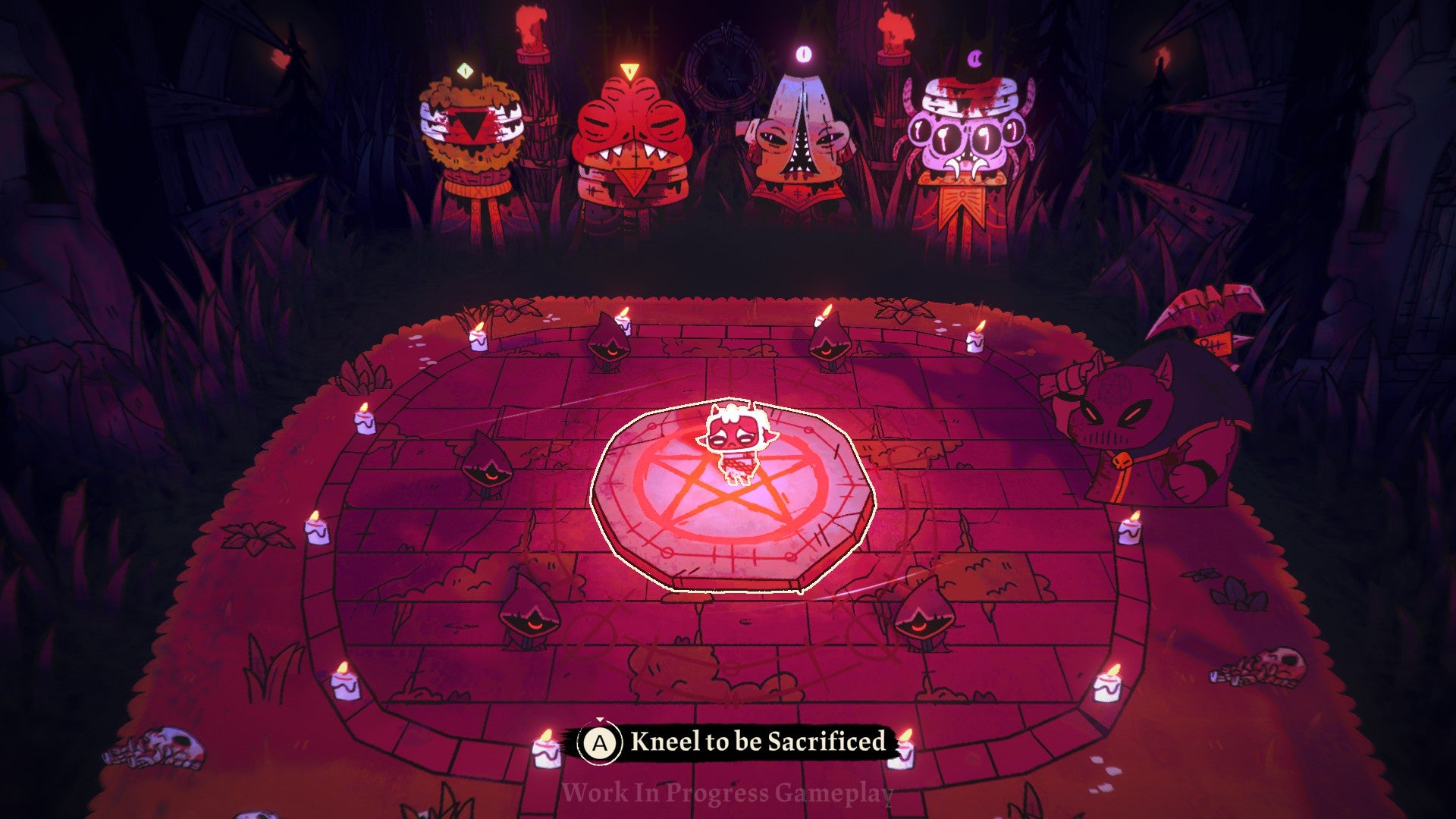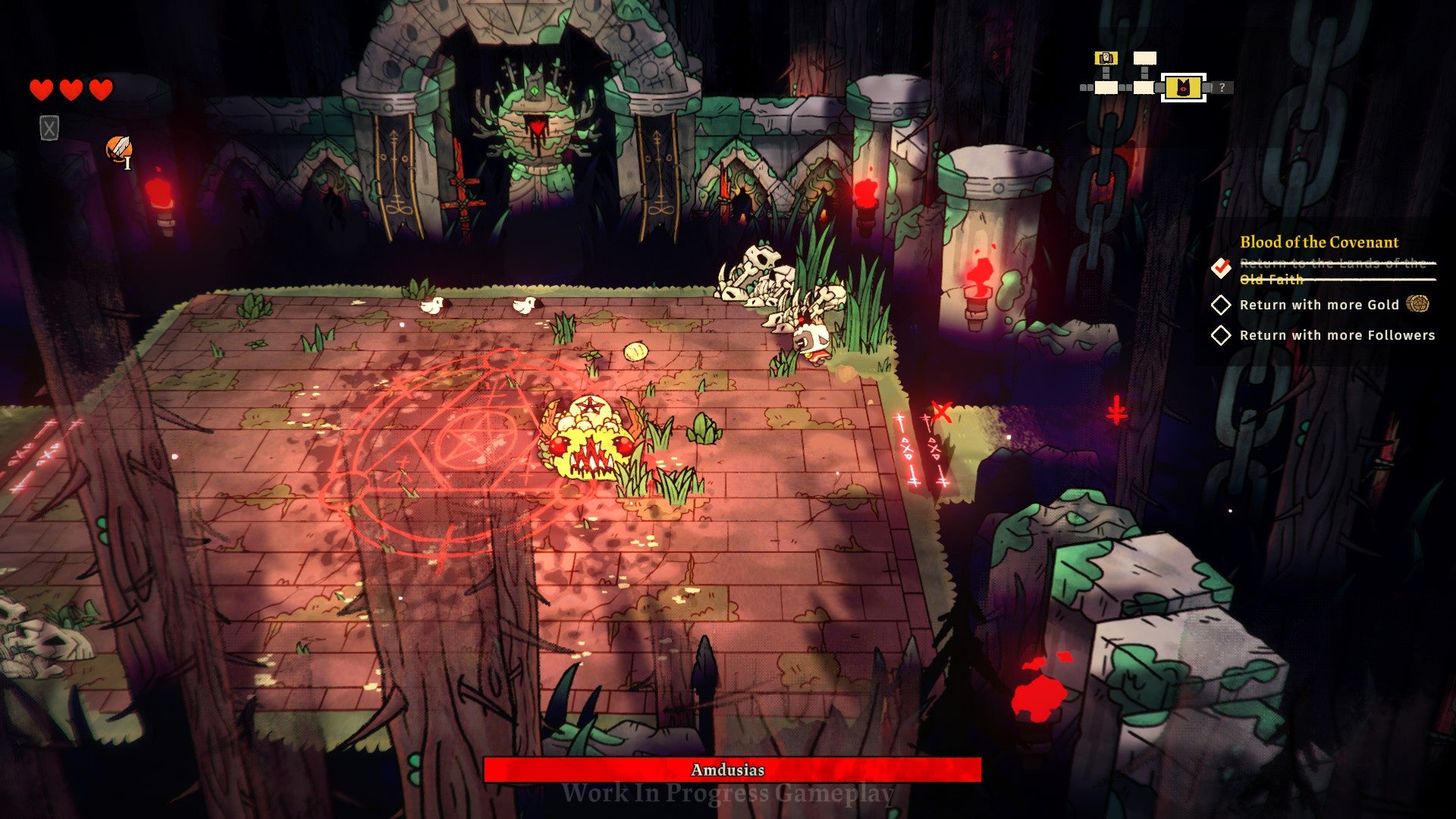I woke early and cooked some food that gave everyone diarrhea. Then I gave a quick sermon to cheer everyone up. I planted some seeds so I could make some more food that gives everyone diarrhea, disappeared for a bit to play a dice game, donated some mushrooms to an old pal in the woods, and caught up on my fishing before heading over to the Gold Guy. I bought some Tarot cards that were going cheap, one of which promises a lovely health boost whenever it gets dealt. I went on a mission and murdered a lot of nasty things in the woods, harvesting resources and whatnot as I went. I killed a boss, working my way up through a sort of watery forest to the next mega boss. Back to the camp after that to clean up all that diarrhea, build a few beds because my followers are sulking, water and fertilise some seeds, knock up a scarecrow so birds don’t eat my seeds, make myself a nice new fleece with lovely perks and then catch the rising sun and do it all over again. I’m tempted, you know, to take up smelting. Cult of the Lamb is a management game and an action roguelite in which you play an evil sheep. It’s astonishingly systems-heavy. You can build dozens of structures to look after your flock, and your flock can grumble and sicken and die and preach behind your back in dozens of ways. You’re always after new cult members, each with their own quirks, and you’re always after the resources to keep everyone happy, because happy cultists in turn give you the resources to make them even happier - and grow more powerful when you set out on action roguelite runs, working your way through minor bosses to middle-management bosses and then hopefully whoever’s at the top. It’s real bust-out-a-pen-and-paper territory. Or it should be, but it isn’t because there’s a secret: each new complexity basically operates in a similar way to the complexities before, and the things you actually have to do are simple: keep everyone alive and busy gathering resources, keep the flock growing, harvest their belief in you and turn it into power and a better base, and then smack monsters around. Simple. The management side is initially the most daunting part, but it quickly becomes pretty straightforward. You can read the minds of your followers to see what they’re after, and good places to start with making them happy are keeping them fed and keeping them rested. The deeper you go the more you cook meals that aren’t going to make everyone sick, and beds that have a little protection from the elements. Their needs grow as your options grow. (And I mean grow. I am a very clumsy machiavellian, as it happens, but even that has its own rewards here. One of my heretics was giving me so much trouble I decided to feed them a poisoned dinner. Sadly, after I’d baked it, I pressed the wrong button and ate it myself.) When everyone’s happy you can dispatch them on various jobs, building stuff, cleaning up, gathering resources or worshipping you - everything feeds back in loops, so resources allow you to build new stuff and worshipping - you know, greater power and all that. Sprinkled in are little mini-games that unlock too. You can fish or play what turns out to be a really excellent dice game of chance and strategy. It’s a decent time-waster in itself and the developers should really spin it off onto iOS so that the last tiny splinter of productivity in my life is ground down for good. And while you’re doing all this stuff, you’re learning what kind of cult leader you want to be. Re-educate dissenters or kill them? Bury dead bodies or harvest the meat? Be your own boss, hun! What a life. When everything’s ticking over nicely, you can embark on crusades, which is the action roguelite part, as you procedurally shuffle the weapons and powers and perks you’re unlocking and smack enemies around room by room. This part of the game is straightforward but filled with a lovely sense of impact. I favour fast, lower damage weapons - whenever I’m sent out with a big heavy hammer, things always end badly. I have a knife I sometimes get to use that leeches HP from baddies, and another that summons ghosts! My favourite skill is a sort of Lovecraftian four-way tentacle blast, or maybe the invulnerability cloud that does damage. Enemy types have a pleasant range and are fun to knock around, and there’s a dodge roll that you really only need when you’re really up against it. I was delighted to discover that enemies can actually kill each other - a hooded cultist might be smacked into oblivion by a falling meteor, say, or my favourite guys, the Snooker Exploding Disco Brains as I like to call them, can be knocked back and into each other, where they then explode in a lovely chain reaction. It’s a game designed for the hit-them-before-they-can-even think approach: ideally you launch yourself into a new room and have all baddies smashed to pieces in a few antic seconds. As you battle through these guys you’re gathering all sorts of resources and unlocking new followers. Like any good roguelite, there’s lovely variation - nice novelty rooms, say, and the occasional optional challenge. Bosses are vivid and both they and their minions often come in the form of demonic spins on the things you hope never to find in a pond or scuttling under a brick. They make the most of the art style, which is all flat paper creatures done up in heavy magic marker. It’s pleasant to rush through this stuff, while a sort of social network timeline ticks by on one side of the screen informing you that everybody back home has started shitting themselves uncontrollably. I like the way these two games come together, and I like the fact that Cult of the Lamb is surprisingly honest about the glinting heart of the whole enterprise - that nearly-mindless busywork is actually kind of fun in the right circumstances. Theoretically you’re doing awful things, imposing bloodthirty doctrines on your flock, offering dalliances with murder and cannibalism and much worse, if there is anything worse. In truth, though, it’s all stats and clicking and power choices. Games are terribly good - and/or worrying - when it comes to obedience. Give me numbers that go up and I’ll do almost anything. I am not fooled by the illusion that I am the one in charge. What lifts it for me, above a clever genre mash-up and a sneaky blend of The Binding of Isaac and a clever, unashamed clicker like Forager, is the art and the delicacy in the visual elements. The designs on the Tarot cards - and the card backs themselves, a personal fascination of mine - are marvels, evocative and briskly captured, like the best New Yorker cartoon. And whenever I drop into the roguelite bit and start moving through those rooms, each one suggests to me of the stage from a particularly evocative school play: creepy witch’s huts, giant mushrooms with tea lights burning away inside. You can tell the teachers really cared about this production of Hansel and Gretel. One set of rooms is entered by a doorway which is itself knee-deep in gentle lapping water. There is a desire to build a world here that is genuinely transporting, and so? And so I was duly transported. Being a cult leader in this funny old game, then, is a little bit like being a game designer, I imagine. It’s complex on certain levels, and to use the lovely vivid cliche, you’re herding cats quite a lot. But really you’re trying to arrange happiness for people. The only difference is that as a cult leader, if they don’t become happy on cue, you can cook them and eat them.


